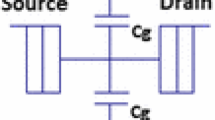Abstract
Spiking Neural Networks propose to mimic nature’s way of recognizing patterns and making decisions in a fuzzy manner. To develop such networks in hardware, a highly manufacturable technology is required. We have proposed a silicon-based leaky integrate and fire (LIF) neuron, on a sufficiently matured 32 nm CMOS silicon-on-insulator (SOI) technology. The floating body effect of the partially depleted (PD) SOI transistor is used to store “holes” generated by impact ionization in the floating body, which performs the “integrate” function. Recombination or equivalent hole loss mimics the “leak” functions. The “hole” storage reduces the source barrier to increase the transistor current. Upon reaching a threshold current level, an external circuit records a “firing” event and resets the SOI MOSFET by draining all the stored holes. In terms of application, the neuron is able to show classification problems with reasonable accuracy. We looked at the effect of scaling experimentally. Channel length scaling reduces voltage for impact ionization and enables sharper impact ionization producing significant designability of the neuron. A circuit equivalence is also demonstrated to understand the dynamics qualitatively. Three distinct regimes are observed during integration based on different hole leakage mechanism.
Similar content being viewed by others
References
G. Indiveri, E. Chicca, and R. Douglas, IEEE Trans. Neural Networks 17, 211–221 (2006).
J. H. B. Wijekoon and P. Dudek, Neural Networks 21, 524–534 (2008).
A. Joubert, B. Belhadj, O. Temam, and R. Heliot, Int. Jt. Conf. Neural Networks, 1–5 (2012).
K. Moon, E. Cha, D. Lee, J. Jang, J. Park, and H. Hwang, Int. Symp. VLSI Technol. Syst. Appl., 9–10 (2016).
T. Tuma, A. Pantazi, M. Le Gallo, A. Sebastian, and E. Eleftheriou, Nature Nanotechnology 11, 693–699 (2016).
S. Lashkare, S. Chouhan, T. Chavan, A. Bhat, P. Kumbhare, and U. Ganguly, IEEE Electron Device Lett. 39, 484–487 (2018).
S. Dutta, V. Kumar, A. Shukla, N. R. Mohapatra, and U. Ganguly, Sci. Rep. 7, 1–9 (2017).
J. Shin, C. Koch, IEEE Trans. Neural Networks 10, 1232–1238 (1999).
A. Gupta and L. Long, Int. Jt. Conf. Neural Networks, 1054–1060 (2009).
A. Biswas, S. Prasad, S. Lashkare, and U. Ganguly, “A simple and efficient SNN and its performance & robustness evaluation method to enable hardware implementation,” arXiv:1612.02233 [cs.NE].
S. Santurkar and B. Rajendran, Int. Jt. Conf. Neural Networks, 1–8 (2015)
Author information
Authors and Affiliations
Rights and permissions
About this article
Cite this article
Dutta, S., Chavan, T., Shukla, S. et al. Dynamics, Design, and Application of a Silicon-on-Insulator Technology Based Neuron. MRS Advances 3, 3347–3357 (2018). https://doi.org/10.1557/adv.2018.490
Published:
Issue Date:
DOI: https://doi.org/10.1557/adv.2018.490




